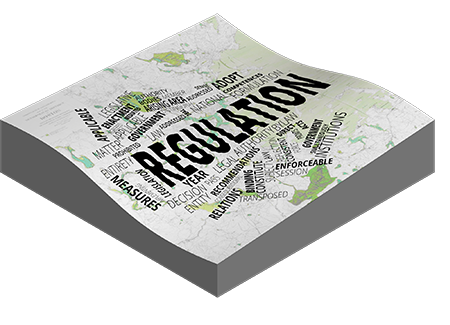Regulatory and Policy Approaches to Address Hazards
Flooding is a natural process that, in the absence of human settlements, is of relatively little concern. However, when human settlements are introduced in to an area where flooding occurs, hazards to life and property from rising flood waters become challenges that must be addressed. Effective floodplain management requires communities to identify and understand which areas in their community are at risk from flooding, create planning and zoning schemes that keep people and infrastructure out of harm’s way, and establish regulations that promote flood safe decision making.
Even with well-drawn maps and clearly articulated plans in place, establishing local laws and regulations are a vital part of protecting valuable natural assets that reduce flood impacts and enabling the use of nature-based solutions to improve community resilience. Regulatory approaches to flood and erosion impacts generally fall in to one of three categories: zoning codes, building codes, and stormwater management ordinances. The sections that follow are intended to provide a more specific look at how each approach can be used to best promote the use of nature based solutions to flood and erosion challenges faced by communities.
Zoning Codes
Zoning can be used to reduce flood impacts in a number of ways. Zoning can be used to keep certain land uses out of vulnerable areas where they may be subject to or contribute to increased flood risk or negatively impact. It can be used to establish requirements for setbacks and buffers that can promote the overall health and effectiveness of natural flood protection. They can also be used to establish retention requirements for keeping stormwater onsite as well as detail which practices are allowed to be utilized when meeting stormwater management requirements.
Land Use
The purpose of floodplain land use regulations are to: protect life, health and property; minimize public expenditures for costly flood control projects; minimize rescue and relief efforts; minimize business interruptions; minimize damage to public facilities; minimize the occurrence of future flood blight areas; discourage the victimization of unwary land and home buyers; and prevent increases in flooding from occurring.
Community officials have a responsibility to protect public health, public safety, the taxpayer’s money, and natural resources. When people get permits to develop property, they trust that their community building officials have done due diligence and it is safe to build. In addition, existing community residents expect that new development will not be permitted that would adversely impact them. The cornerstone of a building permit program is to manage human development in order to prevent or reduce flood hazards to people, flood damage to property, and loss of natural floodplain functions. Managing human development is done through regulations that govern the use of land, alterations of the ground, and the construction of buildings and other structures. In simplest terms, zoning codes can be used to prevent or reduce the impacts of development in highly vulnerable areas by limiting the uses for that land. Some communities require proposals for development to provide a No Adverse Impact certification (see City of Brevard, NC case study) to ensure it does not adversely impact others in the community.
Bulk Regulations
By regulating the amount of land that can be covered with structures and other improvements, zoning codes affect the amount of pervious surface area that can absorb stormwater before it ever flows into drainage systems. Bulk regulations include minimum building setbacks, minimum open space requirements/lot coverage maximums, and floor area ratio requirements. Each of these limits the amount of developed area on a given property and, when looked at cumulatively across an entire community, can help to manage stormwater before it becomes a flooding issue. Requiring a minimum portion of each lot to be preserved as green, open space is an effectively “free” way to preserve natural stormwater infiltration. Bulk regulations are most effective when combined with a commitment from elected and appointed board, council, and commission members to limit zoning variations/variances from those code provisions that preserve and protect open space.
Setbacks and Buffers
Floodplains, streams, rivers, coastal wetlands, dunes and beaches all provide hazard reduction benefits. But encroaching development is a threat to each habitats overall health and ability to reduce flood and erosion impacts. Establishing adequate setbacks and buffers – legal requirements limiting how close development can occur to each habitat type – is one means of protecting the integrity of these natural protective features. Minimum setbacks can lessen the effects of nearby development as well as provide some area for dynamic systems – rivers, streams, and even coastal wetlands – to shift over time.
The Association of State Wetland Managers has developed guidance and suggestions on model code for wetland and riparian buffers, while the Georgetown Climate Center has developed guidance for coastal setbacks and buffers with a focus on adapting to the impacts of sea level rise.
Stormwater Management
As development increases in an area, the overall ability of the natural system to absorb stormwater is reduced, which can lead to flooding and erosion issues as run-off from parking lots, driveways, and other impermeable surfaces begins to overwhelm existing drainage infrastructure. To better manage these issues, stormwater management ordinances generally focus on establishing how much stormwater needs to be retained on an individual site or detailing the options for how that stormwater could be retained. It is important to ensure that, if specific practices are required or encouraged (such as green roofs, green parking lots, or bioswales), the regulatory framework supports and enables their implementation.
The EPA has collected extensive guidance on how best to use policy and regulation to support green infrastructure stormwater solutions.
Summary
While regulation can be contentious, it is also a necessary step in advancing a vision of resilience. Effective maps and well thought out plans will only take a community so far. Regulations and policy are essential tools to implementing plans and managing community risk in a way that takes advantage of the benefits of nature-based solutions. Identifying what uses are applicable in which areas, establishing protections and safeguards for existing natural infrastructure, and creating the enabling conditions and requirements for investment in green infrastructure to address stormwater run-off are all steps on the path to more hazard resilient communities.
Additional Resources
The Association of State Floodplain Managers has put together a guide for increasing regulatory standards in floodplain management that focuses on reducing flood impacts in general, with some guidance and information that is relevant to the use of nature based solutions as well as coastal specific guidance on managing flooding.
The Georgetown Climate Center has created a Green Infrastructure Toolkit focused on helping implement green infrastructure practices that may reduce stormwater runoff.



